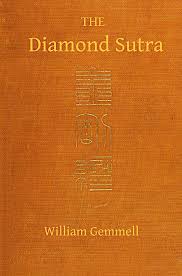The Diamond Sutra, also known as the Vajracchedika Prajnaparamita Sutra, is one of the most revered texts in Mahayana Buddhism. It is part of the Prajnaparamita (Perfection of Wisdom) literature, which emphasizes the concept of emptiness (śūnyatā) and the non-substantiality of all phenomena.
1. Historical Background
Origin
- Composed in India between the 2nd and 5th centuries CE.
- Attributed to the Buddha’s teachings, it was later translated into Chinese by the monk Kumārajīva in the 5th century CE.
Significance
- The Diamond Sutra is one of the oldest known printed books, with a woodblock-printed copy dating back to 868 CE.
- It holds a central place in Mahayana Buddhism, particularly in Zen and Chan traditions.
2. Content and Structure
Form
- The sutra is a dialogue between the Buddha and his disciple Subhuti.
- It is composed of 32 sections, each addressing different aspects of Buddhist philosophy and practice.
Key Themes
- Emptiness (Śūnyatā): The ultimate reality is beyond all forms and concepts. All phenomena are devoid of inherent existence.
- Non-Attachment: Practitioners are encouraged to let go of all attachments, including the attachment to the self and to the merit gained from good deeds.
- Compassion and Wisdom: The cultivation of wisdom and compassion is essential for the path to enlightenment.
3. Major Teachings
Illusion of the Self
- The sutra challenges the notion of a permanent, unchanging self. It emphasizes that the self is an illusion and that understanding this is crucial for attaining wisdom.
Practice of Non-Attachment
- Practitioners are advised to perform good deeds without attachment to the results. This selfless action leads to true merit and progress on the path to enlightenment.
Nature of Reality
- Reality is described as transient and illusory. True understanding comes from recognizing that all phenomena are like dreams, bubbles, shadows, or illusions.
4. Influence and Legacy
Impact on Buddhist Practice
- The Diamond Sutra has profoundly influenced Buddhist thought and practice, particularly in the Zen and Chan traditions where it is frequently studied and recited.
- It serves as a foundational text for understanding the concept of emptiness and the practice of non-attachment.
Cultural and Historical Impact
- The discovery of the printed Diamond Sutra in the Dunhuang Caves highlighted the advanced state of printing technology in ancient China and has been a significant artifact in the study of early printing and manuscript culture.
5. Interpretation and Commentaries
Interpretative Approaches
- Scholars and practitioners have written numerous commentaries on the Diamond Sutra, each offering different perspectives on its profound teachings.
- Interpretations often focus on the practical application of its teachings in daily life and meditation practice.
Modern Relevance
- The Diamond Sutra continues to be relevant in contemporary Buddhist practice, offering insights into the nature of reality and the path to liberation.
- It is studied and revered not only by Buddhists but also by those interested in philosophy and spiritual practice.
Conclusion
The Diamond Sutra remains a timeless and influential text in Mahayana Buddhism. Its teachings on emptiness, non-attachment, and the illusory nature of reality continue to inspire and guide practitioners on the path to enlightenment. Its historical significance as one of the earliest printed books also underscores its enduring legacy in both religious and cultural contexts.



